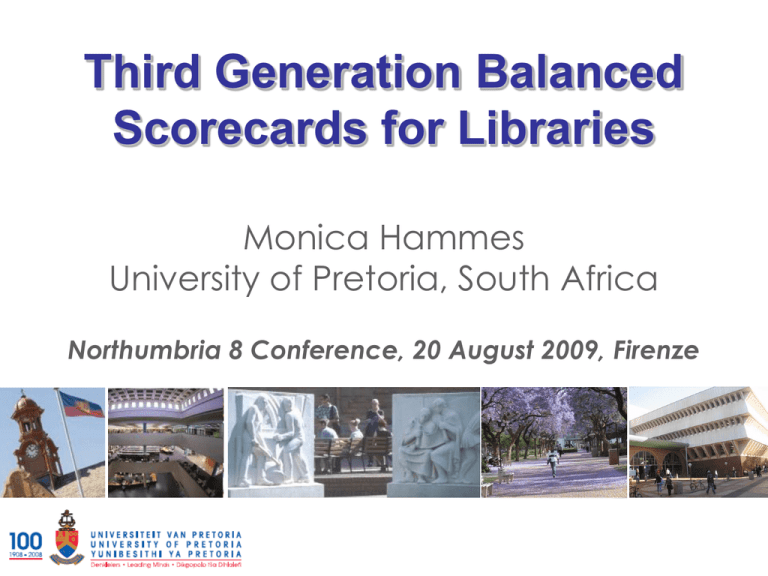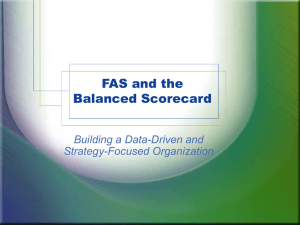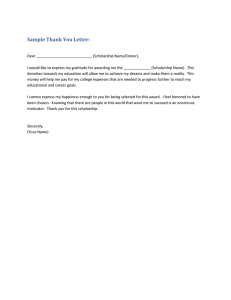Third Generation Balanced Scorecards for Libraries Monica Hammes University of Pretoria, South Africa
advertisement

Third Generation Balanced Scorecards for Libraries Monica Hammes University of Pretoria, South Africa Northumbria 8 Conference, 20 August 2009, Firenze 1 Outline Historical overview Libraries and the Balanced Scorecard Case study: University of Pretoria Open Scholarship Programme Conclusion 2 Balanced Scorecard Basics 1992 4 Perspectives: -financial -customers -internal business processes -learning and growth 5-6 good measures for each Most important perspective at 12h00 Goal: balance and future readiness Compatible with the needs of non-profit organizations but they should also pay more attention to financial measures 3 1st Generation Shortcomings Vagueness Lack of direction with regard to measure selection (from a vast range of possibilities) and measure clustering Confidence and resulting buy-in was low Disappointing results 4 New Insights 2nd Generation Successful implementation was reported whenever the BSC supported major strategic initiatives robmillard.com Additional perspectives will not necessarily guide the organisation towards doing and measuring the right things The right things are already included in the strategic plan MEASURE STRATEGY IMPLEMENTATION AND EXECUTION! 5 2nd Generation: BSC’s strategic niche Clarifying and translating strategy Making strategy operational Driving strategy execution Identifying and aligning strategic initiatives Linking resources with strategy Aligning the organization with strategy 6 Kaplan, R. S. and Norton, D. P. (2000) The strategyfocused organization: how balanced scorecard companies thrive in the new business environment. Harvard Business School Press, Boston, Mass. 7 2nd Generation: The Strategy Map Framework for describing and visualizing strategy Outcomes and the strategic objectives to fulfill them Grouped according to the BSC perspectives Cause and effect relationships between objectives describe the logic of the strategy and prevent nonrelated objectives from creeping into the model Unpacking and translating strategy to make it MEANINGFUL, ACTIONABLE, MEASURABLE 8 3rd Generation BSC Developments Multiple scorecards for complex organizations Destination statement: what will the organization look like when success has been achieved? Active involvement of management needed to write the destination statement commitment Simplified linkage model: Outcome & Activity 9 Libraries and the BSC Enthusiasm, experimentation, survivors Few signs of 2nd and 3rd generation implementations Few strategy maps Two well-established examples 1) German BIX project 2) Measuring quality: Performance Measurement in Libraries 10 UP Open Scholarship Programme To change scholarship practice at the University of Pretoria towards becoming an Open Scholarship institution with the following characteristics 1. Theses and dissertations are available online with open access based on a policy of mandatory submission 2. Research and conference papers are available online with open access and researchers actively contribute based on a policy of mandatory submission 3. Researchers and students actively use open access material 4. Researchers publish in available open access journals and the institution has policy and financial support in place for that 11 UP Open Scholarship Programme (2) 5. Researchers actively manage the copyright of their publications, inter alia with addenda to their contracts or using Creative Commons contracts, and the necessary policy exists 6. Publications from the institution's press/publishing house are available in open access based on policy 7. The institution publishes its own online open access journals OR provides infrastructure and support for members of its community who are involved with society publishing 8. Dissemination forms part of the University’s publication strategies www.ais.up.ac.za/openup/ 12 The following slide provides context for the programme: it forms part of the Library Strategic Areas • Enabling research: impact positively on research, and • E-Strategy: developing, implementing and integrating e-services to enhance UP research, learning, teaching, and Library products 13 We strive to be a world-class 21st century academic research library enabling the University of Pretoria to be an internationally recognized research university LIBRARY STRATEGIC AREAS Information Collection Information Literacy Enable research LIBRARY STRATEGIES 2006 2007 2009 2008 2010 2009 Redefine the information collection to meet the challenges of the new information environment Enhance information literacy for academic success lifelongeLiteracy learning & byLife-long using anLearning integrated Teachand Students Skills approach 2010 UP STRATEGIC THRUSTS Academic excellence People centered institution Impact positively on research and e-research Learning & teaching excellence Develop Research Research Support Strengthen the role of theImplement Library in the facilitation of Support Strategylearning and teaching Strategy E-Strategy Develop new Research Support Role for Develop, implement and integrate e-services to Information Specialists enhance UP research, learning, teaching & Library services Excellence in core functions Excellence in support functions Local impact Community development Contribute to community development Open Access to Scholarly Material HR Obtain, retain and train staff with relevant competencies and attitude Sustainability Ensure the sustainability of the library: Financial health, Quality assurance, Physical facilities, Marketing, Fundraising, Risk management Transformation Interfaces Sustainability Performance measurement needed New(ish) initiative straddling two important strategic areas New manager with limited experience How good is open access actually? Return on investment needs financial indicators Managing a “virtual” team and many role players need clear strategy communication Existing measures and quality assurance activities do not provide adequate indicators to assess performance 15 If you are not keeping score, you are just practicing Balanced Scorecard for Dummies 16 Developing the strategy map 1. Outline the value creation context 2. Identify clients and stakeholders, develop client/stakeholder value proposition 3. Identify financial goals 4. Describe internal processes necessary to fulfill financial goals and client/stakeholder value proposition in terms of Operations Management, Customer Management and Innovation 5. Identify and describe the Human Capital, Information Capital and Organizational Capital that will provide capacity to drive the other three perspectives 6. Indicate logical linkage 7. Identify and describe appropriate measures 17 1: Outline the value creation context UP: … promotion of scholarship Mission Why we exist Values What’s important for us UP:.. share information and knowledge Vision What we want to be World class modern university that contributes to international knowledge Strategy Our game plan Establish effective and sustainable open scholarship programme Strategy map Strategy translated Balaced Scorecard Measure and focus Targets and initiatives What we need to do Personal objectives What I need to do 18 2: Develop client/stakeholder value proposition International researchers and public # Free and easy access to quality research results # Remote online access # Manageable downloading UP Researchers (staff and post-graduate students) # Visibility # One-stop access to own publications # Effective research reporting # Guaranteed archiving # Uncomplicated submission process UP and Other Stakeholders # Comprehensive view of research # Increased impact and reputation # Efficient research reporting more income # Mutually advantageous relationship with publishers 3: Identify financial goals Cost-effective programme Let others and computers do the work More research related income for University 4: Describe internal processes # Implement mandates: coordinate combined effort # Build and manage repositories # Manage quality # Negotiate with publishers on copyright # Contribute to research report # Develop policy and standards # Embed UPeTD fully in postgraduate programme using Oracle # Migrate UPeTD (theses and dissertations) to new platform # Create positive comfort zone for self-archiving (researchers), and advocacy (library staff): # Infrastructure # Provide information, guidance, support # Provide training and training material # Lobbying, advocacy, marketing 5: Identify and describe capacity needs Information capital # Customize/integrate systems: DSpace, Oracle, RIMS # Capture and re-use our knowledge # Create copyright/accreditation databases Human capital # Develop strategic competencies (project management and quality editing) # Raise strategic awareness # Optimise “virtual” teamwork # Develop the ability to assess progress Organizational capital # Coordinate Library and UP operations # Strengthen strategic alliances with Dept Research Support, faculties, publishers and Academy of Science of SA 6: Add logical linkage 23 7: Identify and describe measures # Collection growth # Collection usage # Anecdotal evidence # Submission cost per item # % self-submissions # Monetary value of “discovered “ papers # Copyright issues resolved # Collection growth # % self-submissions 24 Conclusion Effective tool for clarifying, translating and communicating strategy Simplifies implementation and monitoring of progress Holistic view of strategy and progress Very effective for developing measures for new initiatives Limited to one programme it is manageable, sustainable and transferable 25 Thank you! Questions and comments monica.hammes@up.ac.za 26




